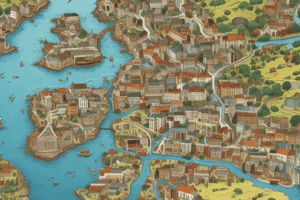Podcast
Questions and Answers
What is the skeletal framework of sponges made of?
What is the skeletal framework of sponges made of?
What is the main role of sponges' specialized cells in filter feeding?
What is the main role of sponges' specialized cells in filter feeding?
How do sponges differ from higher animals in terms of body structure?
How do sponges differ from higher animals in terms of body structure?
What is the main function of pinacocytes in sponges?
What is the main function of pinacocytes in sponges?
Why are sponges often referred to as 'lower animals'?
Why are sponges often referred to as 'lower animals'?
What is the role of collared cells in sponges?
What is the role of collared cells in sponges?
How do sponges feed on food particles?
How do sponges feed on food particles?
What is expelled by sponges through the osculum?
What is expelled by sponges through the osculum?
Why are sponges considered vital in marine ecosystems?
Why are sponges considered vital in marine ecosystems?
Study Notes
Discovering Sub-Kingdom Parazoa: Exploring Sponges, Cell Organization, and Filter Feeding
Sub-kingdom Parazoa, home to the enigmatic and mesmerizing sponges, is a unique and fascinating branch of the animal kingdom. In this educationally rich trek through the highlights of Parazoa, we'll delve into the intriguing features of sponges, their cellular organization, and their role as filter feeders.
The Sponges of Parazoa
Sponges, or Porifera, are simple animals that appear almost plant-like. But don't be fooled by their humble appearance; these organisms are full of marvels. Sponges lack a defined body plan, tissues, and organs, yet they possess some of the most basic cell types, such as specialized cells for filter feeding and defense.
Sponges are classified as multicellular organisms, but unlike higher animals, they lack a true body cavity or organs. Instead, they possess a porous body composed of a skeletal framework called the spongin mesh—made of protein—or spicules—made of calcium carbonate or silica. This skeletal structure provides support and helps filter water, making sponges filter feeders.
Cell Organization in Sponges
The cellular organization of sponges is unique to the animal kingdom. They exhibit the following characteristics:
- Amesoblasts: Sponges have specialized cells called amesoblasts that enable them to form new tissue, a feature absent in most other animals.
- Pinacocytes: These are the main cells of the body wall, responsible for water transport and the formation of the spongocoel, a large cavity within the sponge body, which serves as a reservoir for water.
- Collared cells: Collared cells are specialized cells with a collar-like protrusion from their body, used for capturing food particles.
Sponges do not possess the typical animal tissues, like muscle and nerve tissues, which is why they are often referred to as "lower animals." However, their cellular organization is fascinating and serves as a vital lesson in understanding the diversity of life.
Filter Feeding and Sponges
Sponges are filter feeders, meaning they consume food by filtering suspended particles from the water that passes through their porous body. The collared cells and the body wall work together to trap food particles, which are then engulfed by goblet cells, a specialized cell type in sponges. Sponges passively filter the water, taking in the nutrients they need and expelling the unwanted material through an opening called the osculum.
Sponges play a vital role in maintaining the health of marine ecosystems, as they filter large volumes of water, removing suspended particles and small organisms, thus serving as a vital link between primary production and higher trophic levels.
Sponges are among the most diverse and ancient animals on Earth, with an estimated 10,000 species. Their unique cellular organization and filter feeding capabilities make them fascinating organisms to study and appreciate. So the next time you're at the beach or diving in the ocean, take a moment to marvel at these beautiful and intriguing sponges.
Studying That Suits You
Use AI to generate personalized quizzes and flashcards to suit your learning preferences.
Description
Delve into the unique features of sponges in sub-kingdom Parazoa, including their cellular organization, filter feeding mechanisms, and ecological importance. Learn about the fascinating world of these ancient and diverse organisms.




